Poultry Processing Industry eTool
Packout » Bone-In/Out
Bone-In Product
(See Bone-Out Product)
Bone-in parts can be packed in a variety of ways. Parts can be bulk packed for commercial use or tray packed for consumer use.
This operation includes the following tasks:
- Task 1: Tray Packer: Places multiple chicken parts on foam tray.
- Task 2: Bagger: Places multiple parts in bag.
- Task 3: Bag Sealer: Seals bag.
Task 1: Tray Packer
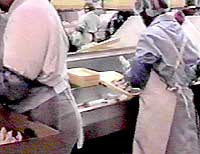
Obtains a tray from a stack of trays and places it on a packing shelf. Employees then reach to obtain product and place it on the tray. Filled trays are placed on a conveyor from which they will later be plastic wrapped.
Hazards of this task may include:
Hazardous Situation
Employees repeatedly reach to access trays, to obtain parts, and to place filled trays on conveyors. Repetitive reaching stresses the shoulder and upper back.
Possible Solutions
- Use diverter bars to push the product closer to the employee.
- Reduce width of conveyor so the product is presented closer to the employee.
- Position packing fixtures, trays, and product so all activities of the task can be performed with the elbows in close to the torso.
- Tilt work surface so product slides to the employee.
- Develop both left- and right-hand stations so employees can rotate through different stations and experience periods of working rest.
- Provide adjustable work tables or stands so task can be performed without torso bending or reaching.
Hazardous Situation
Standing for a long time reduces blood flow to the legs, forces isolated muscles to work for an extended time, and increases risk of fatigue and varicose veins.
Possible Solutions
- Install sit/stand stools, which allow employees to lean and have their weight supported while still remaining in an upright posture.
- Rotate employees to tasks that do not require prolonged standing.
- Provide shoe insoles that cushion the feet and spread foot pressure over a larger surface.
- Provide a foot rest in front of employees so they can shift their posture.
Task 2: Bagger
Bagger places bone-in parts in a plastic bag. A bagging fixture that holds the bag in the open position is often used. After parts are bagged they are generally placed back on the conveyor for packing.
Hazards of this task may include:
Hazardous Situation
Employees repeatedly reach into bins to obtain parts for packaging and to obtain bags in which to place the parts. Repetitive reaching stresses the shoulder and upper back.
Possible Solutions
- Use diverter bars to push the product closer to the employee.
- Reduce width of conveyor so the product is presented closer to the employee.
- Position packing fixtures and product so all activities of the task can be performed with the elbows in close to the torso.
- Tilt work surface so product slides to the employee.
- Develop both left- and right-hand stations so employees can rotate through different stations and experience periods of working rest.
- Provide adjustable work tables or stand so task can be performed without torso bending or reaching.
Hazardous Situation
Standing for a long time reduces blood flow to the legs, forces isolated muscles to work for an extended time, and increases risk of fatigue and varicose veins.
Possible Solutions
- Install sit/stand stools, which allow employees to lean and have their weight supported while still remaining in an upright posture.
- Rotate employees to tasks that do not require prolonged standing.
- Provide shoe insoles that cushion the feet and spread foot pressure over a larger surface.
- Provide a foot rest in front of employees so they can shift their posture.
Task 3: Bag Sealer
The bag sealer removes bagged parts from a conveyor and then directs the end of the bag into the bag sealer. Sealed product is then placed back on the conveyor so it can be boxed.
Hazards of this task may include:
Hazardous Situation
Employees repeatedly reach into bins to obtain parts for repackaging and to obtain bags to place the parts in. Repetitive reaching stresses the shoulder and upper back.
Possible Solutions
- Use diverter bars to push the product closer to the employee.
- Reduce width of conveyor so the product is presented closer to the employee.
- Tilt work surface so product slides to employee.
- Position bag sealing machines so employees may maintain neutral postures.
- Develop both left- and right-hand stations so employees can rotate through different stations and provide periods of working rest for employees.
- Provide adjustable work tables or stands so task can be performed without torso bending or reaching.
Hazardous Situation
Sealing the bag is also repetitive, as the employee must use pinch grips to grasp, lift, and feed the bag into the sealing machine.
Possible Solutions
- Rotate employees to tasks that do not require the use of repetitive forceful pinch grips.
- Use automatic bag sealers.
- Arrange the workstation so bags can slide while being moved from conveyors to sealing machines. This will limit lifting bags and reduce necessary finger force.
Bone-Out Product
(See: Bone-In Product)
Bone-out product is generally produced for consumer use. Bone-out parts can be packed in a variety of ways. Parts can be frozen and bagged bulk. Fresh product can be tray packed.
This operation includes the following tasks:
- Task 1: Quick Freeze Line Loader: Places bone-out product on conveyor for feeding into quick freeze unit.
- Task 2: Quick Freeze Bagger: Removes quick freeze product from conveyor and packs in bag.
- Task 3: Tray Packer: Places multiple parts on foam tray.
- Task 4: Bag Sealer: Seals bag.
Task 1: Quick Freeze Line Loader
The quick freeze line loader places product on a conveyor, which feeds it into quick freeze unit.
Hazards of this task may include:
Hazardous Situation
Employees repeatedly reach to obtain parts for placement on a conveyor and then reach to place the parts on the conveyor. Repetitive reaching stresses the shoulder and upper back.
Possible Solutions
- Use diverter bars to push the product closer to the employee.
- Reduce width of conveyor so the product is presented closer to the employee.
- Position supplies and product so all activities of the task can be performed with the elbows in close to the torso.
- Develop both left- and right-hand stations so employees can rotate through different stations and experience periods of working rest.
- Provide adjustable work tables or stands so task can be performed without torso bending or reaching.
Hazardous Situation
Standing for a long time reduces blood flow to the legs, forces isolated muscles to work for an extended time, and increases risk of fatigue and varicose veins.
Possible Solutions
- Install sit/stand stools, which allow employees to lean and have their weight supported while still remaining in an upright posture.
- Rotate employees to tasks that do not require prolonged standing.
- Provide shoe insoles that cushion the feet and spread foot pressure over a larger surface.
- Provide a foot rest in front of employees so they can shift their posture.
Task 2: Quick Freeze Bagger
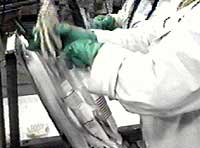
The bagger places quick frozen parts into a bag, which is held by a bagging fixture. When filled, the bag is placed on a conveyor for sealing and packing.
Hazards of this task may include:
Hazardous Situation
Employees repeatedly reach to conveyors to obtain frozen parts for bagging and reach to place filled bags back on the conveyor. If bagging fixtures are placed on top of tables that are too high, employees may need to reach up to above shoulder height to place product into bags. Repetitive reaching stresses the shoulder and upper back.
Possible Solutions
- Use diverter bars to push the product closer to the employee.
- Reduce width of conveyor so the product is presented closer to the employee.
- Position bagging fixtures and product so all activities of the task can be performed with the elbows in close to the torso.
- Tilt work surface so product slides to employee.
- Develop both left- and right-hand stations so employees can rotate through different stations and experience periods of working rest.
- Provide adjustable work tables or stands so task can be performed without torso bending or reaching.
Hazardous Situation
Standing for a long time reduces blood flow to the legs, forces isolated muscles to work for an extended time, and increases risk of fatigue and varicose veins.
Possible Solutions
- Install sit/stand stools, which allow employees to lean and have their weight supported while still remaining in an upright posture.
- Rotate employees between tasks that require prolonged standing.
- Provide shoe insoles that cushion the feet and spread foot pressure over a larger surface.
- Provide a foot rest in front of employees so they can shift their posture.
Hazardous Situation
Sealing the bag is also repetitive, as the employee must manually press the air out of the bag and use pinch grips to twist and feed the bag into the sealing machine.
Possible Solutions
- Rotate employees to tasks that do not require using repetitive forceful pinch grips.
- Use automatic bag sealers.
- Arrange the workstation so bags can slide while being moved from conveyors to sealing machines. This will limit lifting bags and reduce necessary finger force.
Hazardous Situation
Employees must grab frozen product and hold it long enough to move it from the conveyor to the bag. Holding cold product can numb the hand, requiring employees to use more finger force to hold the product. Anything that increases the amount of finger force that must be used increases the risk of injury to the hand and forearm.
Possible Solutions
- Provide employees with properly fitting gloves.
- Develop an automated bagging machine so employees don't touch the product.
Task 3: Tray Packer

Obtains a tray from a stack of trays and places it on a packing shelf. Employees then reach to obtain product and place it on the tray. Filled trays are placed on a conveyor from which they will later be plastic wrapped.
Hazards of this task may include:
Hazardous Situation
Employees repeatedly reach to access trays, to obtain parts, and to place filled trays on conveyors. Repetitive reaching stresses the shoulder and upper back.
Possible Solutions
- Use diverter bars to push the product closer to the employee.
- Reduce width of conveyor so the product is presented closer to the employee.
- Position packing fixtures, trays, and product so all activities of the task can be performed with the elbows in close to the torso.
- Tilt work surface so product slides to the employee.
- Develop both left- and right-hand stations so employees can rotate through different stations and experience periods of working rest.
- Provide adjustable work tables or stands so task can be performed without torso bending or reaching.
Hazardous Situation
Standing for a long time reduces blood flow to the legs, forces isolated muscles to work for an extended time, and increases risk of fatigue and varicose veins.
Possible Solutions
- Install sit/stand stools, which allow employees to lean and have their weight supported while still remaining in an upright posture.
- Rotate employees to tasks that do not require prolonged standing.
- Provide shoe insoles that cushion the feet and spread foot pressure over a larger surface.
- Provide a foot rest in front of employees so they can shift their posture.
Task 4: Tender Puller
Tender pullers use their fingers to pull tenders away from the breast bone after the main section of breast has been removed. This task may be performed while the carcass is on the cone line or from a cut full breast placed on a flat work surface.
Hazards of this task may include:
Hazardous Situation
Employees repeatedly reach into bins to obtain parts for repackaging and to obtain bags to place the parts in. Repetitive reaching stresses the shoulder and upper back.
Possible Solutions
- Use diverter bars to push the product closer to the employee.
- Reduce width of conveyor so the product is presented closer to the employee.
- Tilt work surface so product slides to employee.
- Position bag sealing machines so employees may maintain neutral postures.
- Develop both left- and right-hand stations so employees can rotate through different stations and provide periods of working rest for employees.
- Provide adjustable work tables or stands so task can be performed without torso bending or reaching.
Hazardous Situation
Sealing the bag is also repetitive, as the employee must use pinch grips to grasp, lift, and feed the bag into the sealing machine.
- Rotate employees to tasks that do not require the use of repetitive forceful pinch grips.
- Use automatic bag sealers.
- Arrange the workstation so bags can slide while being moved from conveyors to sealing machines. This will limit lifting bags and reduce necessary finger force.


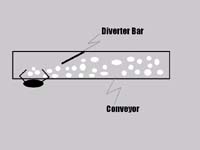 Diverter bars push materials on a conveyor belt closer to an employee. This reduces the amount of reaching and reduces stress to the shoulder, upper back, and neck.
Diverter bars push materials on a conveyor belt closer to an employee. This reduces the amount of reaching and reduces stress to the shoulder, upper back, and neck.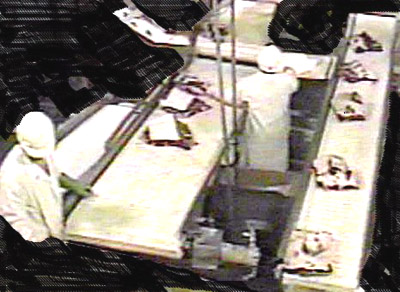 Conveyors should only be as wide as is necessary to accommodate the product. Using overly wide conveyors forces employees to reach out and away from their bodies, which stresses the shoulder, upper back, and neck.
Conveyors should only be as wide as is necessary to accommodate the product. Using overly wide conveyors forces employees to reach out and away from their bodies, which stresses the shoulder, upper back, and neck.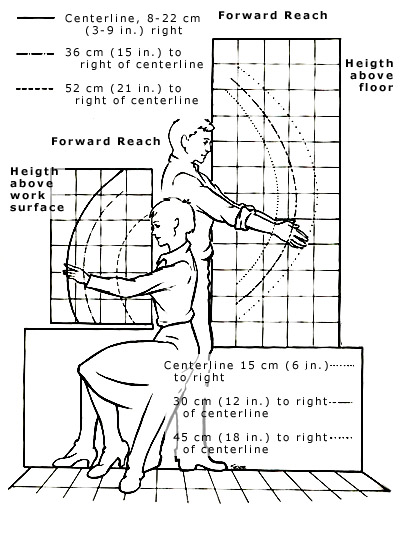
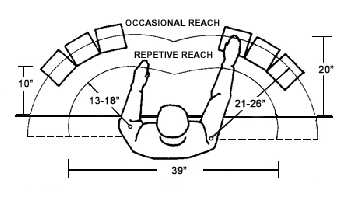
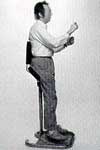
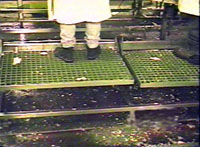 Work stations should generally be designed for the tallest employees who are likely to use them, to reduce the need for these employees to bend at the waist while performing their task. Using height adjustable stands allows employees of shorter body sizes to work at the same workstation without using awkward postures such as reaching above shoulder height. Stands should be easily adjustable at the beginning of shift without special tools or training.
Work stations should generally be designed for the tallest employees who are likely to use them, to reduce the need for these employees to bend at the waist while performing their task. Using height adjustable stands allows employees of shorter body sizes to work at the same workstation without using awkward postures such as reaching above shoulder height. Stands should be easily adjustable at the beginning of shift without special tools or training.